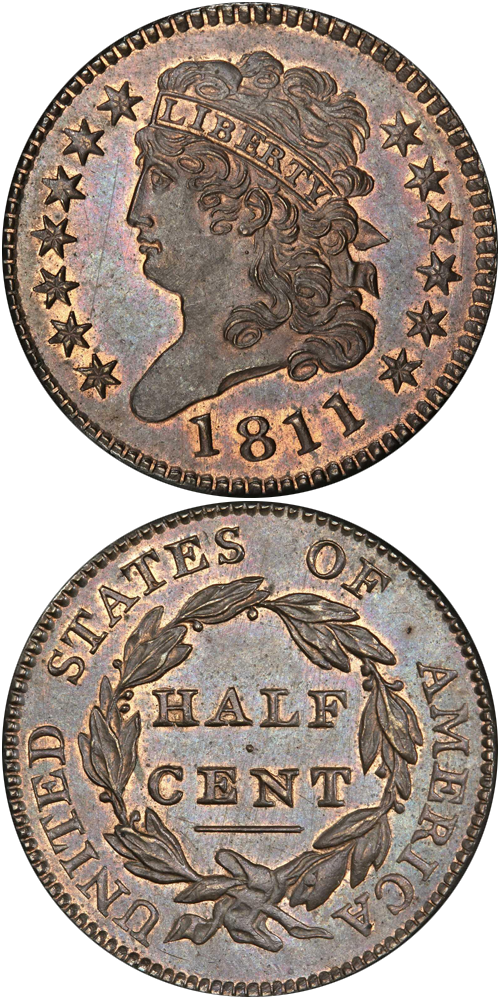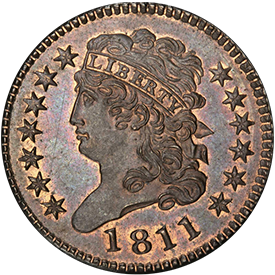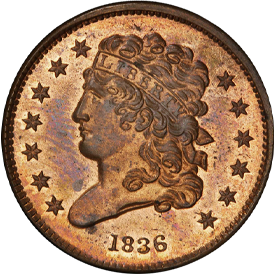Designed by: John Reich
Issue Dates: 1809-1836
Composition: Copper
Diameter: 23.5 mm
Weight: 5.44 grams (84 grains)
Edge: Plain
Business Strike Mintage: 3,635,712
Approximate Proof Mintage: 100 to 200, mostly restrikes
The so-called Classic Head design by John Reich made its appearance on half cents in 1809, postdating by one year its debut in the large cent series. A somewhat related motif was used years later on the $2½ and $5 gold coins of 1834. Miss Liberty faces right. Her hair is in curls, close to her head, and is secured by a band inscribed LIBERTY. Seven stars are to the left and six to the right. The date is below. The reverse consists of a continuous wreath tied at the bottom with a ribbon, enclosing HALF CENT at the center, with UNITED STATES OF AMERICA around the border.
Specimens of this type are readily available in all grades from Good through Uncirculated, although, interestingly enough, specimens in Good to Very Good grade are scarcer than those in Fine through Extremely Fine, for at the time of issue half cents did not circulate extensively, so they were not subject to as much wear as were contemporary large cents, for example. Uncirculated coins can be obtained of a number of dates within this span, but the most often seen are those of 1828, 1833, and 1835. Such pieces, if they have original mint red, are apt to have flecks or spots as a result of dampness. Beware of cleaned or "processed" pieces masking as ''Uncirculated” for such pieces abound.
1831 and 1836 are exceedingly rare; most known specimens are Proofs, many of them being restrikes. Original Proofs were struck of certain dates toward the end of the era, and all are very difficult to locate.
Further Reading
The year 1809 was the first that the so-called Classic Head half cents were made. This design was earlier featured on the large cents of 1808 and is believed to represent the work of John Reich. Turban Head is an alternative designation for the motif.
Mint records show a coinage of 1,154,572 half cents for 1809, the largest within the entire generation. Early in the year the Mint had nearly 1,500,000 uncoined half cent planchets on hand. Apparently, the pieces were produced simply to clear the supply of old planchets and to keep the presses busy, for there was little apparent commercial demand for them. So extensive was the mintage that quantities of the next two years were reduced sharply, after which a long span occurred without any half cent production at all. Supplies of the 1809 half cents were kept on hand and were not distributed for many years. In the process many Uncirculated pieces were saved, with the result that today specimens in this grade are encountered with some regularity. All of the pieces I have seen show toning to some degree – I have never seen a full mint red piece of original color.
In addition to the so-called normal date, two major varieties of 1809 have captured the attention of collectors. The first is the so-called "1809/6." This is not an overdate at all but, rather, is a result of a die cutting error. The last digit of the date was erroneously cut upside down. It was then hastily recut in the correct position. A more accurate description would be "1809 over upside down 9." However, as an upside down 9 is also a 6, the difference is academic, but an explanation is in order for if the 9 had been cut over a previously-made 1806 die, the motif would have been of the Draped Bust style.
The second variety is the Circle Inside 0 issue. The 0 was first punched slightly too small and then recut with a normal-size punch. The inner 0 and outer 0 are both visible.
Among all half cents minted from 1793 through 1857, the 1809 is the most frequently seen in the numismatic marketplace, closely followed by 1804 as a date (without regard for specific varieties).
Coins of the following year, 1810, are fairly scarce. Most are weakly struck on the right-hand side of the obverse. The reported mintage of 215,000 was accomplished from a single pair of dies. Specimens are usually seen in circulated grades, but a few Mint State pieces, not with full original color, are known.
Half cents of 1811 have always been considered scarce by collectors and dealers. Indeed, specimens bearing this date are encountered with much less frequency than others of the era. In Uncirculated preservation 1811 half cents are great rarities. Two original die varieties were produced. One was struck from an obverse die that failed and developed a break that gradually encompassed the first four stars on the left.
Among the most curious and fascinating of all half cents is the 1811 restrike employing a reverse die of 1802. In the late 1850s the Mint disposed of several dozen or more old dies by selling them as "scrap iron." As luck would have it, Joseph J. Mickley, a numismatist, came into the possession of some of these and proceeded to produce restrikes. Probably to avoid fooling anyone, he used an entirely different reverse die from that employed originally, a reverse of 1802 featuring an open wreath, a style entirely different from that used in 1811.
According to what has been printed in numismatic literature over the years, only six of the 1802 restrikes were coined, although the number known today seems to be closer to 10. The ownership of one of these has always been considered to be a prime accomplishment by specialists in the field, as the piece represents rarity, an unusual or illogical die combination, and numismatic history. While some would question the status of such a piece, it was nonetheless struck from official United States Mint dies. At least the production was accomplished openly. Is this better or worse than some similar productions, such as the 1804 silver dollar, which were secretly produced at the Philadelphia Mint and marketed along with pious pronouncements that they were "original" items?
I have always considered the 1811 half cent to be one of the most interesting of all pieces. In the course of handling numerous collections over the years I have examined three or four 1811 half cents, including pieces auctioned as part of the Century Collection in 1965 and the Virgil Brand Collection in 1983. Roger Cohen writes, "A new collector need not worry about having a restrike sold to him as an original, since the present market price of the restrike is in excess of a Mint-coined 1811."
The large remaining supply of 1809-dated half cents, together with the sluggish circulation of other half cents produced during the same era, resulted in suspension of coinage after 1811. From then until 1825 no examples were made. The denomination was never very popular in commercial channels. Occasional contemporary references can be found of merchants refusing to accept them, banks not wanting them, and of other rejections.
Half cents of 1825 follow the Classic Head style of 1809-1811 coinage. Mintage for the date was reported as 63,000, but as the frequency of specimens seen in the numismatic marketplace indicates a higher figure, quite probably many of the 234,000 reported coined for the following year, 1826, were actually dated 1825. Two die varieties of 1825 half cents were made. As a date the 1825 is plentiful in circulated grades but is quite elusive in Mint State.
Likewise, two die varieties were produced of the 1826 half cent, varieties distinguished only by minor features. As a date the 1826 is quite plentiful in all grades except Uncirculated. Specimens of 1825 and 1826 with generous amounts of original mint red are rarities. However, in recent decades, particularly since approximately 1960, the philosophy that "brilliant is best" has become quite prevalent, with the result that untold numbers of glossy lustrous brown Uncirculated half cents and large cents, pieces of exquisite desirability and attractiveness, have been "dipped" or "processed" to make them varying degrees of bright red and orange, a numismatic shame. As a result of this practice, published advertisements and auction catalogue listings featuring "Brilliant Uncirculated" half cents of these and other earlier years must be taken with a very large grain of salt!
From this era onward die variations become minute, and a magnifying glass is needed to differentiate them. Thus, assembling different issues of this period is in the realm of what one writer characterized as "collecting by microscope." Happily, there are some exceptions. An example is the 1828 12-star half cent.
No coins of the half cent denomination were struck in 1827. ln 1828 pieces were again made, with the Mint reporting a production of 606,000 pieces, some of which may have been dated 1826. While most were of the standard configuration with 13 stars on the obverse, a few were produced with just 12. Evidently someone at the Mint was daydreaming and forgot to arrange the stars properly. The same type of error occurs in other places among United States coins, notably the 15-star large cent of 1817 and the 12-star $5 gold piece of 1832. The anomalous star count on the 1828 half cent has made this a particular favorite with collectors. Pieces are semi-scarce in lower grades and are quite rare in Uncirculated condition.
By contrast, regular (13 stars) 1828 half cents are seen with frequency in all grades from Fine to AU, and even Uncirculated pieces are encountered with a degree of regularity. The latter examples may trace their pedigree to the so-called Collins hoard found in Alexandria, Virginia, toward the end of the nineteenth century. Benjamin H. Collins, who was a coin dealer with close connections to the Treasury Department, is reported to have purchased more than 1,000 pieces, relates a note in the Cohen book. A typical Uncirculated 1828 is nearly full mint red but with inevitable flyspecks or light spotting.
1829 half cents were produced to the extent of 487,000 pieces according to Mint reports. Virtually all found their way into circulation or were subsequently melted. Uncirculated pieces displaying full or nearly full mint red are rarities, and even glossy brown Uncirculated pieces are not seen often.
Later (1828 and subsequent years) Classic Head and other half cents circulated neither intensely nor for a long period of time. As a result, for the collector today specimens in lower grades such as Good and Very Good become increasingly elusive (but not necessarily numismatically desirable) as the calendar pages turn over.
The year 1831 offers a number of unusual varieties, all of which are exceedingly rare. Most 1831 half cents known today are in Proof condition. Mint reports indicate that 2,200 business strikes were produced. Apparently, a few pieces actually circulated, for worn coins are occasionally seen today. Such pieces are extremely rare. Restrikes were produced on several occasions and are divided into two main varieties. The first employs a wreath with large berries, the so-called Reverse of 1836. The second is of the modified style of wreath generally used from 1840 through 1857.
The 1831 restrike employing the reverse first regularly used (but only for Proof coinage) in 1840 is one of the most curious in the series. As is the case with the 1811 half cent utilizing the reverse of 1802, the making of the 1831 with the reverse style of 1840-48 was illogical. Like the 1811 restrike, this variety of 1831 restrike is a major rarity. Walter Breen, who studied the pieces and reported his findings in The Encyclopedia of United States and Colonial Proof Coins, could trace only four examples!
From 1832 through 1835 half cents were again minted in large quantities for circulation. A Guide Book of United States Coins cites figures of 154,000 for 1832, 120,000 for 1833, 141,000 for 1834, and 398,000 for 1835. It is possible that there may have been some overlapping of production as far as actual dating of the dies is concerned.
Half cents of this date span are readily available in grades from Fine to glossy brown Uncirculated. 1833 occasionally is seen with a prooflike surface, a state often catalogued as full Proof. Uncirculated pieces with nearly full mint red, usually peppered with some flyspecks, are often seen of the 1835 year, due to a hoard estimated at approximately 1,000 pieces dispersed early in the present century.
The terminal issue among Classic Head half cents, the 1836, is somewhat similar to the 1831 in that nearly all known specimens are Proofs. The few worn pieces that have appeared from time to time are believed to be Proofs which were spent for one reason or another. A number of Proofs, probably no more than two dozen, were made in 1836. Later the same pair of dies was used to produce restrikes. Whereas original Proofs weigh 84 grains, more or less, restrikes from the same dies usually weigh several grains less. In a situation resembling that of 1831, the 1836 Classic Head obverse was combined with a reverse used to coin Proofs of the 1840-1848 era. These illogical pieces are exceedingly rare, and only about a half dozen can be traced.
They may have been products of the mind of Dr. Henry Linderman, director of the Mint, for in an auction of his coins held in 1888 two specimens appeared. Linderman, like certain other Mint officials of the 1850-1885 era, was very much in the "coin business." Restrikes and other delicacies were served up to eager dealers who had customers waiting for them. The art of numismatic detective work was not as well developed a century ago as it is today, and many illogical pieces were simply accepted as rarities at the time. Today, restrikes are not necessarily undesirable. Indeed, the most famous of all American numismatic issues, an issue which B. Max Mehl noted as "The King of American Coins," the 1804 dollar, is perhaps the most desired rarity in the American silver series, although all known specimens were made at least three decades after 1804. In recent decades the story behind such pieces has become known.
Before progressing to the next half cent design type, it is appropriate to mention the 1837 half cent token. This piece, which for many years has been listed and illustrated in the half cent series in the Guide Book of United States Coins, has no official significance or status. It is properly a privately-issued token produced as part of the so-called Hard Times token series. The obverse depicts a perched eagle with the date 1837 below. The reverse illustrates a wreath. The inscriptions relate to the metallic content and weight. Years ago, Wayte Raymond, distributor of the 'National" series of coin albums, included the 1837 token as part of the United States half cent series as a challenge to collectors, as no regular half cents of this date were made. As these 1837 tokens were inexpensive at the time – worth just a dollar or two – it was no financial hardship to acquire one. Over the years this token has been "adopted" by collectors. Today, examples encountered usually range from Fine to Extremely Fine.








